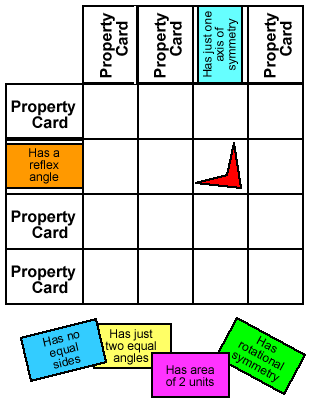Or search by topic
Number and algebra
Geometry and measure
Probability and statistics
Working mathematically
Advanced mathematics
For younger learners
Property Chart



Property Chart printable sheet - grid and instructions
Property Chart printable sheet - quadrilateral cards
Property Chart printable sheet - triangle cards
Printable spotty paper - square grid, isometric grid
Shuffle eight of the quadrilateral cards, and lay them on the grid in the spaces marked "property card". Your challenge is to draw a quadrilateral in each square, so that the quadrilateral has both the properties at the top of the column and at the start of the row. There might be some that aren't
possible! If you like, you could play this with a friend, taking turns to draw shapes. If you can't draw a shape, pass and see whether your partner can, the winner is the one who draws the last shape.
You might find it helpful to draw the shapes on spotty paper; there are squares here and isometric paper here (this might help you find areas and angles).

What's the smallest number of different shapes you need to fill in the grid? What shapes are these, and what cards did you use?

You may also like
Linkage
Four rods, two of length a and two of length b, are linked to form a kite. The linkage is moveable so that the angles change. What is the maximum area of the kite?
Making Rectangles, Making Squares
How many differently shaped rectangles can you build using these equilateral and isosceles triangles? Can you make a square?
The Cyclic Quadrilateral
This gives a short summary of the properties and theorems of cyclic quadrilaterals and links to some practical examples to be found elsewhere on the site.

